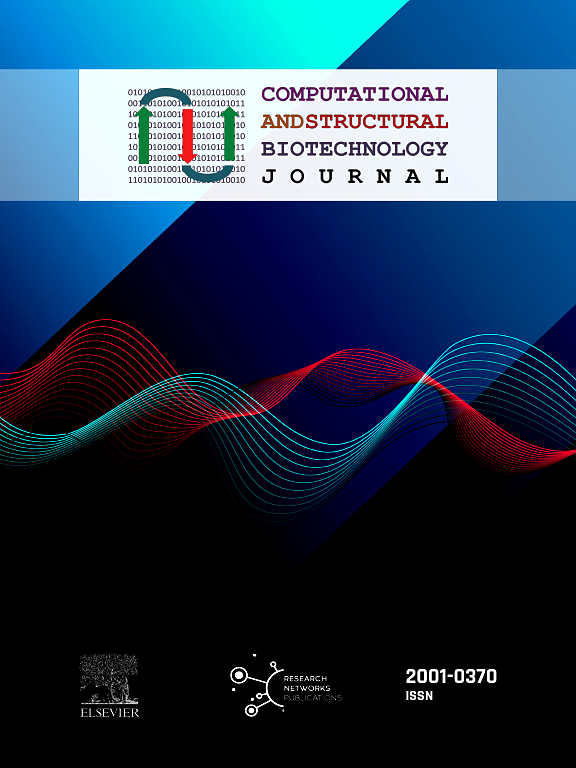Computationally derived structural insights into Rare Earth selectivity in lanmodulin and its variants
IF 4.4
2区 生物学
Q2 BIOCHEMISTRY & MOLECULAR BIOLOGY
Computational and structural biotechnology journal
Pub Date : 2025-01-01
DOI:10.1016/j.csbj.2025.02.005
引用次数: 0
Abstract
Understanding rare earth element (REE) binding to proteins enables the engineering of selective protein-based ligands for precise REE recovery. Lanmodulin (LanM), with notable REE selectivity and picomolar binding affinity, is a promising candidate. This study shows that LanM variants employ distinct inter-residue interactions for REE binding. We detail the thermodynamics and structural aspects of binding events in wild-type (WT) Methylorubrum extorquens LanM and five EF-hand residue variants (4P2A and 4D9X, X = N, A, H, M), using protein variant structure prediction, molecular dynamics simulations and binding motif exploration. We demonstrate strong agreement between experimental binding measurements (apparent Kd) and in silico binding energy scores of WT, 4 P2A, and 4D9X LanMs. We systematically investigate the role of solvent dielectric, sample multiple force fields, and initial protein structure bias on metal ion-binding energetics. In addition, we identify amino acids outside the direct metal binding motif crucial for coordinating the binding events which is corroborated with experimental binding characteristics of 4D9X variants. Computationally measured binding affinity with contribution from this secondary set of residues show agreement with the experimental Kd values and suggests how some point mutations can induce long-range structural perturbations to regulate metal ion-protein recognition and interactions. Finally, we analyze structural changes arising from alterations in side-chain flexibility of each amino acid on the protein backbone at the instant of metal binding and recognition – which manifests as altered helicity at a specific locus of the protein, a result that is corroborative of the observations from circular dichroism experiments.
计算得出稀土在lanmodulin及其变体中选择性的结构见解
了解稀土元素(REE)与蛋白质的结合使得基于蛋白质的选择性配体的工程设计能够精确地回收REE。Lanmodulin (LanM)具有明显的稀土选择性和皮摩尔结合亲和力,是一种很有前途的候选物质。该研究表明,LanM变体采用不同的残基间相互作用进行REE结合。我们详细介绍了野生型(WT) Methylorubrum敲诈勒索LanM和5个EF-hand残基变体(4P2A和4D9X, X = N, A, H, M)结合事件的热力学和结构方面,使用蛋白质变异结构预测,分子动力学模拟和结合基序探索。我们证明了WT、4 P2A和4D9X LanMs的实验结合测量(表观Kd)和硅结合能评分之间的强烈一致性。我们系统地研究了溶剂介质、样品多重力场和初始蛋白质结构偏差对金属离子结合热力学的作用。此外,我们鉴定了直接金属结合基序之外的氨基酸,这些氨基酸对协调结合事件至关重要,这与4D9X变体的实验结合特征相证实。计算测量的结合亲和力与这组次级残基的贡献显示与实验Kd值一致,并表明一些点突变如何诱导远程结构扰动来调节金属离子-蛋白质的识别和相互作用。最后,我们分析了在金属结合和识别的瞬间,蛋白质主链上每个氨基酸侧链柔韧性的改变所引起的结构变化,这表现为蛋白质特定位点的螺旋度的改变,这一结果证实了从圆二色性实验中观察到的结果。
本文章由计算机程序翻译,如有差异,请以英文原文为准。
求助全文
约1分钟内获得全文
求助全文
来源期刊

Computational and structural biotechnology journal
Biochemistry, Genetics and Molecular Biology-Biophysics
CiteScore
9.30
自引率
3.30%
发文量
540
审稿时长
6 weeks
期刊介绍:
Computational and Structural Biotechnology Journal (CSBJ) is an online gold open access journal publishing research articles and reviews after full peer review. All articles are published, without barriers to access, immediately upon acceptance. The journal places a strong emphasis on functional and mechanistic understanding of how molecular components in a biological process work together through the application of computational methods. Structural data may provide such insights, but they are not a pre-requisite for publication in the journal. Specific areas of interest include, but are not limited to:
Structure and function of proteins, nucleic acids and other macromolecules
Structure and function of multi-component complexes
Protein folding, processing and degradation
Enzymology
Computational and structural studies of plant systems
Microbial Informatics
Genomics
Proteomics
Metabolomics
Algorithms and Hypothesis in Bioinformatics
Mathematical and Theoretical Biology
Computational Chemistry and Drug Discovery
Microscopy and Molecular Imaging
Nanotechnology
Systems and Synthetic Biology
 求助内容:
求助内容: 应助结果提醒方式:
应助结果提醒方式:


